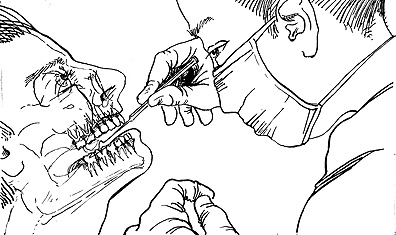Bad dentistry is more serious and more prevalent than most Americans realize, in fact, it may be our most under-reported health problem. Many people are losing not only their teeth, but also their lives, to bad dental work. Faulty dental work can instigate a whole array of degenerative and fatal diseases. Bad dentistry can cause skin problems, hair loss, nerve damage, paralysis, diseased organs, severe depression, chronic insomnia, suicide, and death by mercury poisoning. As widespread as bad dentistry is, you're likely to be victimized by it sometime during your life.
"Conservative estimates show that at least 15 percent of dentists are unqualified, incompetent, or dishonest- and these figures are considered far, far too low by many. Some even talk in terms of half the dental practitioners," says Dr. Arthur Freese in his book Managing Your Doctor (Stein & Day 1975; p.81). The 2/97 Reader's Digest ("How Honest Are Dentists?" by William Ecenbarger) featured an investigative report in which someone visited fifty dentists in as many cities for exams and treatment. Forty-nine out of fifty dentists prescribed unnecessary work.
My own anecdotal research on the streets of Seattle has led me to believe that an honest and competent dentist is very hard to find. I've held free public meetings in order to educate people about the problem, passed out flyers to promote these meetings, and worked on this past year's dental initiative, thereby getting plenty of feedback from the public on the subject of dentistry.
One man told me that when he was a boy, a dentist wanted to fill twelve of his teeth, informing him he had twelve cavities. Since he'd never had dental problems, he found this hard to believe and sought a second opinion. The second dentist told him he had no cavities. At the time he and his mother were living on welfare, so he assumed the first dentist was trying to take advantage of the welfare system . . . at the expense of his teeth. Days later I met a woman who said a dentist wanted to fill one tooth unnecessarily. "Just one?" I asked.

A woman on the bus saw the dental petition I had and gave me the story of what happened to a friend of hers. A dentist let the drill slip and the drill went through the patient's lip. The dentist then took some heavy thread and stitched the lip together. It became infected, with serious complications.
This is only a sampling of the stories I heard. It seems most people have some horror story about something that went wrong in the dentist's chair.
In spite of the frequency of bad dental work, there seems to be a "disconnect" regarding the problem. People are anaware that they are not alone in their experiences. Public consciousness of the problem hasn't surfaced yet.
Death by Dentistry
In Root Canal Cover Up (Bion, 1994), Dr. George Meinig tells how you can die from root canal work. What he doesn't tell is that the need for root canals is created by dentists themselves- dentists who miss cavities, allowing these to grow into the pulps of teeth.
Also, perhaps by now you've heard that so-called silver fillings are, to a great extent, mercury fillings. The main ingredient is mercury- about 50 percent -mixed with copper, silver, and usually some tin or zinc. In spite of what what your dentist may say, the mercury does leach out from these fillings, which the American Dental Association has never factually denied. Yet most dentists will not give up their love affair with mercury. And no wonder, it's one of the fastest ways for dentists to ruin teeth and make a bundle of money in the process.
Since the 1970s, "high copper" amalgams have been in general use. These are fillings containing more copper and less silver than older amalgams had. This is one reason the newer amalgams break down so fast. Also, they release mercury into your system fifty times faster than the old amalgams did, according to the celebrated Colorado dentist, Dr. Hal Huggins in It's All In Your Head: Diseases Caused by Silver-Mercury Fillings (Life Sciences Press 1989). Because these high-copper amalgams wear out sooner, you have to make more frequent trips to the dentist. These amalgams don't bond with the tooth as do composite fillings, thereby causing leakage around or under the fillings. This leads to recurrent decay and root canal infections.
Nor are all composite fillings safe; some contain nickel, a carcinogen. In addition to unsafe dental materials and procedures is the problem of just plain sloppy dental work itself: bad contacts, bad occlusions, overhangs, open margins, and missed cavities. Once dentists are out of school, they tend to become careless, and this carelessness results in irreversible injuries to consumers.
You may also want to check out theFree Press article "How Many Dentists do we Really Need" by Doug Collins in our Sept/Oct 1996 issue. You can also access this at the Seattle Public Library downtown or the University of Washington periodicals collection.
Marjorie Rhodes is starting a file on dental problems in the Seattle area. She's also the author of How to Know if You're Going to a Bad Dentist, a 76-page book ($6.00 plus $1.75 shipping, .52 WA tax). To contact her, write to Box 45435, Seattle, 98145.
 |
 |
 |
 |
 |
Contents this page were published in the January/February, 1998 edition of the Washington Free Press.
WFP, 1463 E. Republican #178, Seattle, WA -USA, 98112. -- WAfreepress@gmail.com
Copyright © 1998 WFP Collective, Inc.